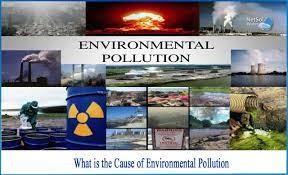The environment is the delicate balance of physical and biological factors that directly influence the survival, growth, development, and reproduction of organisms. Unfortunately, human activities have led to the introduction of pollutants into the environment, causing harm and disruption. In this chapter, we will analyze Environmental pollution’s causes effects and solutions. We will explore various aspects of environmental pollution, including its types, effects, and some key solutions.
Pollutant: A pollutant is any substance present in the environment in greater proportions than its normal abundance, resulting in harmful or detrimental effects on the quality of the environment. These pollutants come in different forms: solid pollutants, liquid pollutants, and gaseous pollutants.
Threshold Limit Value (TLV) of Common Pollutants: Threshold Limit Value (TLV) is the minimum permissible average concentration limit of a toxic pollutant under which a worker can work safely for 40 hours in a week. Here are the TLV values for some common pollutants:
- Carbon Dioxide (CO2): 5000 ppm
- Carbon Monoxide (CO): 50 ppm
- Sulfur Dioxide (SO2): 5 ppm
- Nitric Oxide (NO): 25 ppm
- Nitrogen Dioxide (NO2): 5 ppm

Primary and Secondary Pollutants
Primary pollutants are harmful chemical substances that directly enter the environment due to natural human activities, such as CO, NO, and SO2. On the other hand, secondary pollutants are formed in the environment through chemical reactions between primary pollutants and atmospheric components. An example is SO3, which forms when O2 reacts with SO2.
Biodegradable vs. Non-biodegradable Pollutants
Biodegradable pollutants can be broken down by microorganisms either naturally or through treatment, e.g., cow dung and domestic sewage. In contrast, non-biodegradable pollutants do not degrade or degrade very slowly, posing a significant threat to humans and the environment. Examples include DDT, mercury, and aluminium.
Haematoxic Effects
Haematoxic effects refer to the toxic effects on blood. Benzene can lead to leukaemia, lead poisoning causes anaemia, and carbon monoxide disrupts the function of hemoglobin, leading to asphyxiation.
Viable and Non-viable Particulates
Viable particulates are small living organisms suspended in the atmosphere, including bacteria, fungi, viruses, and algae. Non-viable particulates, produced by burning fossil fuels, (Environmental Pollution: Causes Effects and Solutions ) come in several forms:
- Dust: Fine particles from the crushing and grinding of solid materials.
- Mist: Formed by the condensation of sprays of liquids, like insecticides.
- Fumes: Condensed vapors, especially from metals.
- Smoke: Small soot particles produced by the combustion of organic matter.
Carbon Monoxide vs. Carbon Dioxide
Carbon monoxide (CO) is more dangerous than carbon dioxide (CO2) because it forms a stable complex called carboxyhemoglobin, reducing the transport of oxygen to cells. In contrast, carbon dioxide is primarily associated with global warming.
Biochemical Oxygen Demand (BOD)
Biochemical Oxygen Demand (BOD) measures the amount of dissolved oxygen needed for aerobic bacteria to decompose organic wastes in a given water sample. High BOD values indicate more pollution in the water.
Chemical Oxygen Demand (COD)
Chemical Oxygen Demand (COD) measures the total oxygen required to chemically decompose organic wastes. COD determination is advantageous over BOD determination as it oxidizes both biologically oxidizable and inert matter more quickly.
Pollution refers to the unfavorable alteration of the environment due to human activities. Four important causes of pollution include chemical substances, geochemical substances (dust, sediment), biological organisms and products, and changes in physical properties (heat, noise).
Understanding environmental pollution is crucial for our planet’s well-being. By recognizing the causes and effects of pollution, we can work towards solutions to protect the environment and our own health. It’s essential for individuals, communities, and governments to take proactive steps to reduce pollution and preserve the Earth for future generations.
For further information: https://www.gktoday.in/
Read our previous articles: https://scitechupdate.com/index.php/treated-wastewater-exerts-an-impact-on-our-rivers/ https://scitechupdate.com/index.php/india-makes-history-by-landing-a-spacecraft-at-the-moons-south-pole/
https://scitechupdate.com/index.php/zinc-air-batteries-could-be-cheaper-and-safer-than-lithium-ion/
https://scitechupdate.com/index.php/android-14-satellite-sms-for-everyone/
https://scitechupdate.com/index.php/chemistry-entrepreneurship/
https://scitechupdate.com/index.php/waste-paper-to-battery-components-for-smarts-phones-vehicles/https://scitechupdate.com/index.php/ai-demonstrated-95-accuracy-in-listening-typing-and-data-processing/
https://scitechupdate.com/index.php/top-7-technology-trends-of-2023-from-ai-to-5d-technology/





